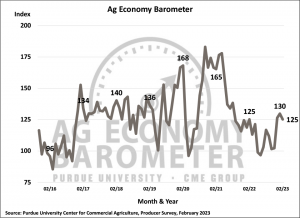The Purdue University-CME Group Ag Economy Barometer Index fell 5 points in February to a reading of 125. Farmers’ perspectives regarding both current conditions on their farms and their expectations for the future both weakened slightly as the Index of Current Conditions fell 2 points to 134 and the Index of Future Expectations declined to 121 compared to 127 in January.
This month’s survey revealed that producers’ confidence in the future growth of U.S. agricultural exports continues to weaken. In addition, although both land value expectation indices remain in positive territory, more producers think farmland values could weaken in the year ahead than on previous surveys.

Producers are less confident this month about farm finances. The Farm Financial Performance Index declined 7 points to a reading of 86. Farmers continue to point to concerns about higher input costs, chosen by 38 percent of February’s survey respondents, as their biggest concern for the year ahead.
Notably, in this month’s survey more producers said they are concerned about the risk of lower crop or livestock prices than just a few months ago. Eighteen percent of this month’s respondents chose lower output prices as one of the top risks they are facing, up from just 8 percent who cited that as a key risk in September.
Concerns about rising interest rates appear to be on an upswing as well. In February, nearly one-fourth of survey respondents (24 percent) chose rising interest rates as a key concern, up from 22 percent in the last two months and up from just 14 percent who cited interest rates as a top concern last summer.
Producer’s confidence in U.S. agriculture’s exporting prowess has weakened considerably since this question was first included in barometer surveys in 2019. Confidence in agricultural exports increasing peaked in 2020 barometer surveys when just over 70 percent of respondents said they expected exports to increase in the upcoming 5 years.

Since then, the percentage of farmers looking for exports to grow over time has drifted lower, dipping to just 33 percent in the February survey. And in this month’s survey, the percentage of respondents who expect U.S. exports to decline reached 18 percent, providing the weakest perspective on future exports since barometer data collection began, suggesting that lack of confidence in future agricultural export growth is contributing to the weak sentiment among producers.
The February reading of the Farm Capital Investment Index changed little this month, rising to 43, just one point higher than a month earlier. Weak capital investment readings have been the norm for nearly two years, despite strong farm income. This consistently weak index is primarily attributed to the increase in prices for machinery and new construction and rising interest rates.
The short and long-term farmland value indices align relatively well with the capital investment readings, weakening slightly in February. The Short-Term Farmland Value Index declined one point to 119 while the Long-Term Farmland Value Index dropped 5 points to 137. Although both indices remain above 100, indicating a positive outlook on farmland values, the percentage of producers who said they expect values to decline over the next 5 years reached 19 percent this month, the highest percentage since this question was first routinely included in barometer surveys in 2019.
This month’s survey question focused on farm growth, and asked respondents what annual growth rate was expected over the next five years. Forty-nine percent of respondents said their farm had no plans to grow or planned to exit or retire, while 22 percent fell into the rapid growth category for 5 to 10 percent annual growth.
The Purdue University-CME Group Ag Economy Barometer sentiment index is calculated each month from 400 U.S. agricultural producers’ responses to a telephone survey. This month’s survey was conducted from February 13 to 17, 2023.


